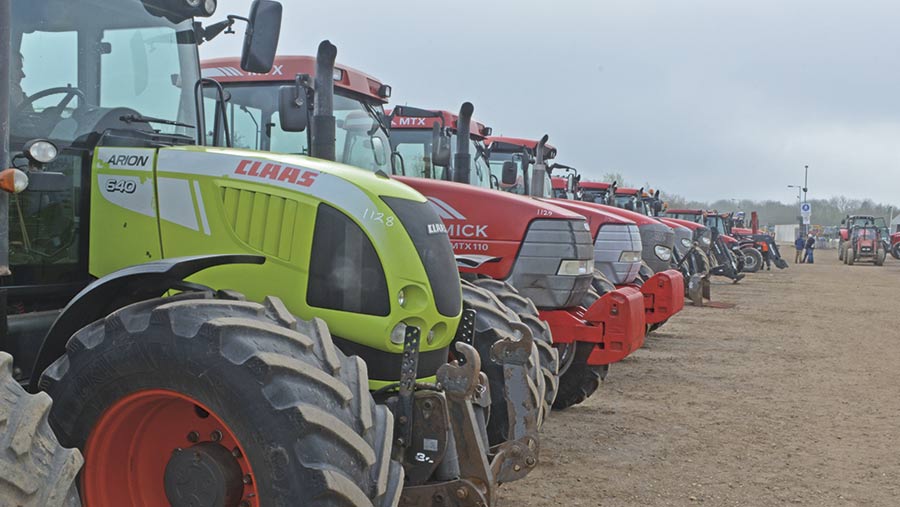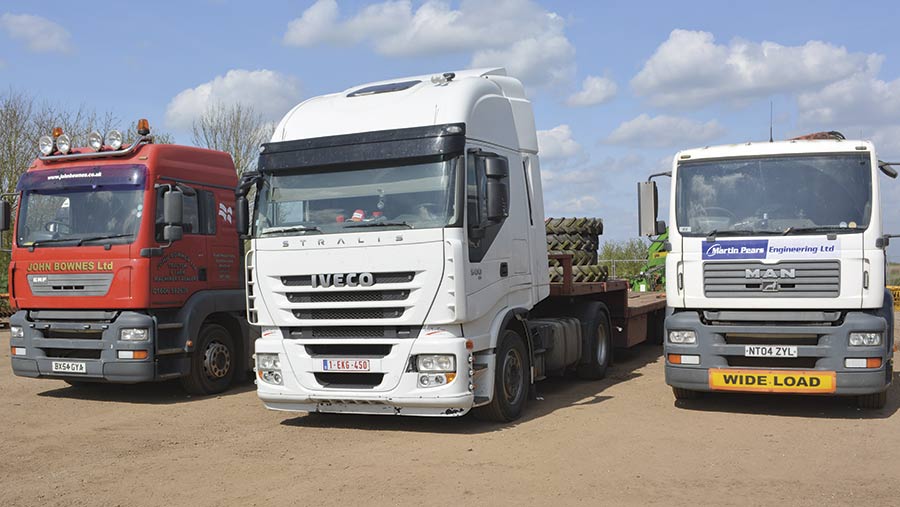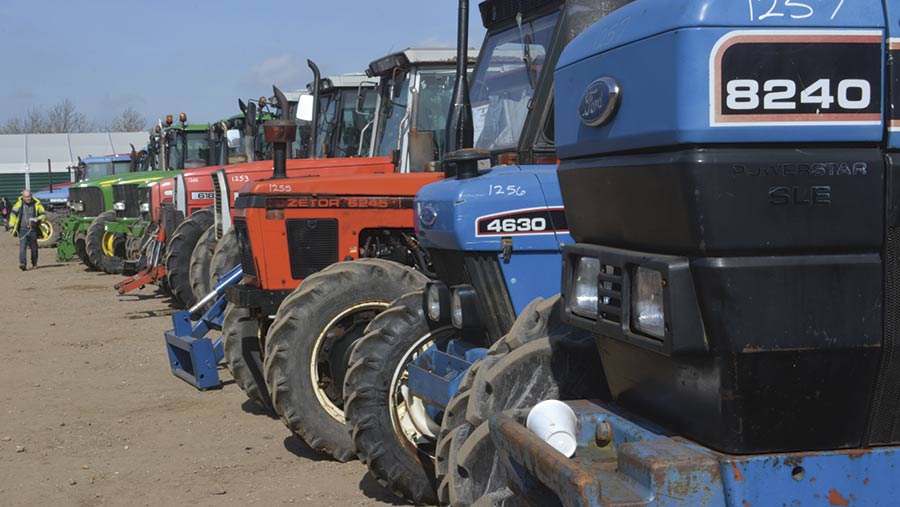Video: What next after Brexit boom for farm machinery sales?
Business has boomed for auctioneers Cheffins since sterling took a tumble following last year’s UK referendum vote to leave the EU.
But there is also an air of trepidation among international buyers who fear that Brexit could hamper trade.
Johann Tasker speaks to Cheffins chairman William Kings at the auction in Ely to ask him about the demand for second-hand farm kit from all over the world. Watch the video and read the report below.
A farm machinery shortage and a 20% fall in the value of sterling since the vote last June have seen more overseas buyers travelling hundreds and even thousands of miles to attend the saleground at Sutton, near Ely, in the heart of the fens.
See also: Best-selling tractor brands in the UK in 2015
“We’re seeing increased interest from exporters as well as the home trade,” says Cheffins chairman William Kings. “We are finding there is a good demand for second-hand machinery – and tractors in particular.”

Rows of second-hand tractors ready to be sold at the Cheffins saleground near Ely, Cambridgeshire © Johann Tasker/RBI
The monthly auction is seen as an important outlet for used and nearly new farm machinery and plant equipment.
See also: At the auctions: Demand soars for second-hand spud gear
Sales are consigned from farmers, other private vendors, UK and overseas dealers, local authorities and national finance companies.
More than 1,000 buyers were in attendance as 300 tractors and 2,700 other lots went under the hammer at this month’s auction on Monday 3 April.
Buyers from Africa, India and south-east Asia rubbed shoulders with fenland farmers and European dealers – all with an eye for a bargain.

Old engines receive a new lease of life after being purchased by international buyers and shipped overseas © Johann Tasker/RBI
Sales of higher horsepower John Deere tractors and JCB Fastracs are proving particularly popular with buyers from Spain, Poland and other European countries, says Mr King. Massey Ferguson and New Holland machines are also in demand.
Machinery dealer Wim Lemahieu regularly travels to the auction from Belgium. He has been coming for more than a decade – purchasing John Deere tractors to take back home and then sell on to local farmers or other retailers.
‘Bounced back’
“Every month there is a good selection of tractors and it is good to be here to see what is happening in the market with the prices and models,” says Mr Lemahieu.
The first few sales after the Brexit vote were a little subdued, but sales have since bounced back, he adds.
More than £34m of second-hand agricultural machinery was sold by Cheffins in 2016.
With sales to more than 100 countries worldwide, the company saw more than 3,000 tractors and more than 4,000 plant items pass through its showground during the year.

Low-loaders queue up – waiting to transport tractors from the showground © Johann Tasker/RBI
Easily accessible from major routes such as the A14 and close to the east coast ports of Harwich and Felixstowe, the saleground’s location means relatively low transport costs for overseas buyers looking to export to Europe and beyond.
But Mr Lemahieu has concerns. A quick turnaround is vital when purchasing machinery in the UK, he says. Any tariffs, additional border checks or other restrictions that slow down trade after Brexit could hamper business, he says.
“We will have to see what happens with the border. We arrive with our truck, unload our older machines to sell and then in the evening after the sale we load up with newer machines that we have bought before leaving again for Belgium.
“If we have problems, I don’t know how we will arrange things. At the moment, we spend one or two days away from home to sell and buy. But if we have to spend three or four days away, it would be too long for us.”
Drive-through auction
Dating back to the 1940s and initially located in the centre of Cambridge, auctioneers celebrated 20 years at today’s 16ha (40-acre) site last July with the introduction of a drive-through tractor auction, allowing bidders to see machines running during bidding.
Many of the older tractors are shipped to developing countries. The auction has long been popular with North African and Middle Eastern buyers – and the dip in the value of sterling means prices are even more favourable for those with foreign currency.

More than 3,000 tractors and over 4,000 plant items passed through the auction last year
Lebanese buyer “JJ” Jaber has been coming to the sale since 1995. A regular commercial buyer visiting the UK almost every month, he says prices are especially attractive at the moment due to the weaker pound. “The currency has changed – it is better for us.”
Mr Jaber is a well-known purchaser of plant equipment as well as tractors and farm machinery, he says it takes just 21 days from buying a machine at Sutton for it to arrive by shipping container in the Lebanon. “They look after you here,” he adds.
Another buyer, Don Hapuarachichi, who is from Sri Lanka, has been coming to the auction since 1968. At the last auction, he bought five or six machines. But he would have liked to buy more. “There is a shortage of container space at the moment, which is holding us back.”
UK and foreign buyers compete for machines
More than 30,000 buyers worldwide are registered with Cheffins. More than 60% of lots are sent for export and more than 20% of sales last year were to the developing world. Regular sales go to Spain, Ireland, Germany, the Middle East, Eastern Europe and Northern Africa.
Top purchasers for 2016 were from Spain, Ireland, Poland, Belgium and Bulgaria. And with sales totals increasing regularly, Cheffins director Bill Pepper says the market for second-hand machinery is booming in both the UK and abroad.
A cocktail of rising prices for new tractors, easing off of new tractor registrations last year, shortage of stock for machinery dealers and drop in trade-ins has brought UK dealers back to the market over recent months, says Mr Pepper.
The export trade is making the most of a drop in the pound, leading to UK and foreign buyers vying against one another. “We have also had a number of farmers entering stock to be sold as they see auction as the best way to achieve the highest prices for stock.”
Spring is the busiest season at the saleground. “Coupled with a weak pound and good export trading conditions, [this] has led to price rises and we are now facing the prospect of a shortage of some of the more popular models of tractors, combines and machinery.”
Top sales at Cheffins in April |
||
|
Top five tractor lots |
||
|
Lot |
Price |
Destination |
|
John Deere 6210R |
£49,000 |
Spain |
|
John Deere 6210R |
£46,000 |
Spain |
|
John Deere 6125R |
£44,000 |
Belgium |
|
John Deere 6150R |
£39,500 |
Portugal |
|
Case STX 440 Quadtrac |
£32,000 |
Germany |
|
Top three plant lots |
||
|
JCB 3CX (Y reg) |
£25,000 |
UK buyer |
|
JCB 3CX (1997) |
£21,000 |
Sri Lanka |
|
JCB 535-140 telehandler |
£27,000 |
Republic of Ireland |
Recovery in demand for new tractors after ‘Brexit blip’
Year on-year UK registrations of new agricultural tractors is also recovering after a “Brexit blip” – soaring by 27% during the first three months of 2017 alone, reveal the latest statistics.
Some 3,024 new machines were registered between January and March, according to the Agricultural Engineers Association. In March alone, 1,770 new machines were registred – an increase of 43.2% compared with the same month last year.
In any given year, March is often the month with the highest number of tractor registrations, as fieldwork gets busier and farmers take delivery of new machines. But the figure for March 2017 the highest total for any month since March 2014.
It follows a year which saw registrations of agricultural tractors over 50hp fall to 10,602 units during 2016 – a decrease of 2.2% on the previous year. In a single month, December 2016 showed a fall of 13.4% to 515 units.
Although the annual total for 2016 was the lowest for more than a decade, the second half of the year saw a substantial recovery after six months that saw registrations drop by 9.8%. In an ongoing trend, the average size of registered tractor increased by 0.8% to 158.3hp.

